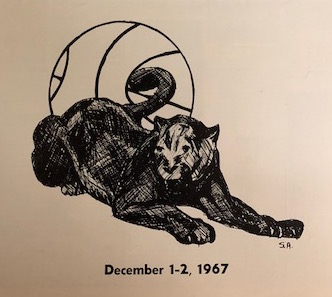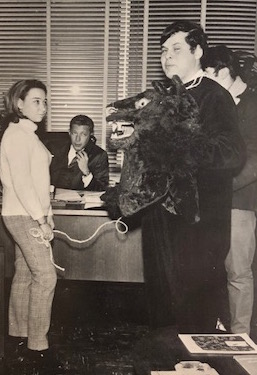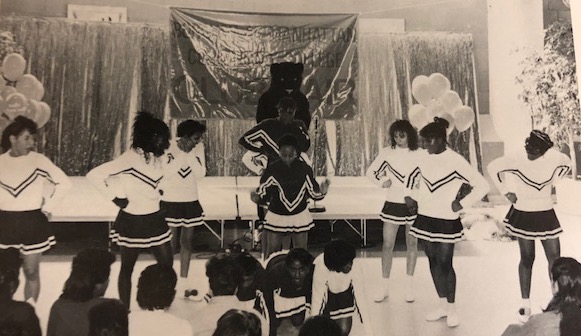
The Borough of Manhattan Community College (BMCC/CUNY) Panther has had a makeover—and BMCC students have given it a new name—Manny (short for Manhattan).
In all, more than 3,000 students responded to an email survey by the office of Student Affairs asking them to choose between the names; Hudson, Pat the Panther, Professor Paws and finally the winner, Manny. Almost half of the student participants selected Manny with Professor Paws coming in a distant second place.
“The BMCC Panther instills pride by generating school spirit, excitement and participation,” said Marva Craig, Vice President of Student Affairs at BMCC.
Mascots such as the BMCC Panther have a storied past. They first arrived on college campuses in the late 1900s, but people dressing up as bears, tigers or elephants did not grow popular until the 1970s. The term itself is rooted in French and means “lucky charm.”
Over the years, colleges within the City University of New York system picked their own mascots, according to the CUNY Athletic Conference. At BMCC, the Panther has been around since the college’s earliest days as a business school located in an office building at 134 West 51st Street and called Manhattan Community College, or MCC.
Tracing the panther’s history
“There was a dress code back then, everyone was required to be in business attire,” said Doug Machovic, a member of MCC’s first graduating class in 1966 who is now a professor of Health Education at BMCC.

Getting ahead in business appears to have been the inspiration behind the original MCC Panther mascot. The Panther “symbolizes the power of knowledge and our drive for success in the business jungle,” said a full-page entry from the 1966 MCC yearbook that includes a drawing of the MCC panther.
Archival material provided by the A. Philip Randolph Library at BMCC, as well as first-person accounts, shows that the MCC Panther first pounced onto the men’s basketball court in late 1965 or early 1966 when the college’s athletic program was being led by William “Dolly” King; sports legend, professor and men’s basketball coach.
One of King’s lead players, Frank Navas, was also a member of MCC’s first graduating class and the college’s first recipient of the Martin B. Dworkis Award for Scholarship, Leadership and Sportsmanship, named after MCC’s first president.
“Our coach, William ‘Dolly’ King was a great athlete, but he was an even greater human being,” said Navas, who is now a professor of accounting at BMCC.
King, who arrived at MCC in 1965 as a Professor of Physical Education, Health and Recreation was a star athlete who played for the all-black New York Renaissance professional team. Then in 1946 King made history when he signed with the all-white Rochester Royals, making him first African American to join the National Basketball League, the predecessor to today’s National Basketball Association.
King has since been recognized as one of the top basketball players of his era according to the Black Fives Foundation, a nonprofit that celebrates the legacy of African Americans in Pre-1950s basketball.
Early panther pride
Spurring the 1967 Panthers onto victory, a spirited cheerleading and booster squad led by Physical Education Professor Mary Jacobs. The cheerleader’s co-captain was Beryl Duncan, who today is Beryl Duncan Wilson, a professor and counselor in BMCC’s College Discovery program.

“I vaguely remember someone at games wearing a distorted animal head—probably intended to look like a Panther,” said Wilson. A photograph from the 1967 MCC yearbook does in fact show what looks to be a student holding the furry head of a panther.
Wilson says she doesn’t know why the college settled on the Panther as a mascot versus a tiger or a bear—although she and others have speculated that it could be related to the Summer 1966 debut of the Marvel Comic Black Panther series.
Despite the college still being in its infancy, Panther Pride was so great during King’s time as coach, busloads of students often traveled with the basketball team to away games at colleges across the region, Wilson says.
By 1969, Coach William “Dolly” King had compiled a 50-7 record during his time at MCC. But on January 28 while at Panthers game in Binghamton, New York, King had a heart attack and died the next morning. He was just 52 years old.
By the 1970s, men’s varsity sports teams, like the college itself, had expanded. Panther teams included cross-country, soccer, track and field and wrestling teams. For women, there was now basketball, bowling, softball, volleyball and cheerleading. There were also club programs in karate and fencing. Drawings of the Panther were showing up in MCC merchandise such as banners, t-shirts and posters, as well as in yearbooks and other publications.
The panther comes to life
The first image of someone dressed in a panther costume shows up in a 1988 BMCC yearbook. By then, BMCC had a new home at 199 Chambers Street and its student body had grown exponentially. BMCC Athletic Director Steve Kelly suggested that the college probably acquired a costume sometime during that period or in the early 1990s. Nonetheless, by the 2000s, the Panther had become an intricate symbol of BMCC’s school spirit and its brand, showing up at basketball games and other events.

Manny the Panther will certainly make an appearance at the college’s 43rd Commencement, on June 1 at the Theater at Madison Square Garden—an opportunity for graduates and their families to meet BMCC’s official ambassador of school spirit.
“The BMCC Panther symbolizes pride and represents oneness for students and the rest of the college community,” said Craig. “It wears the college colors of orange and blue, fostering school spirit, positive identity with the college, and enthusiastic participation at special and athletic events.”
STORY HIGHLIGHTS
- BMCC unveils new Panther mascot costume and name
- Early Panther pride inspired by history-making coach
- New mascot’s name decided by students

